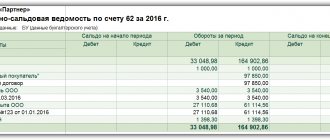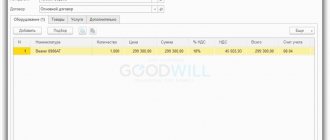Which card is better to have - debit or credit?
For corporate purposes, it is possible to issue various versions of bank cards:
- debit only (the card will be replenished with funds before they can be spent);
- credit (funds on the card are provided by the bank within the limit);
- debit with overdraft (there is the possibility of spending funds in excess of the debit balance - as a rule, also limited).
Which card to choose depends on the purposes for which it is issued, as well as on a certain degree of trust in the employee who will use it. For example, if a card is issued to a manager for use on business trips, including foreign ones, it is advisable to provide for the possibility of spending funds on a loan or overdraft (“extra” money may come in handy). If the card is issued to a business owner for regular small purchases within the budget, the best option may be a debit card with a fixed monthly replenishment.
NOTE! If a credit card has a period of interest-free use of credit funds, the economic benefit from such use for tax purposes does not need to be calculated (see letter of the Ministry of Finance dated April 18, 2012 No. 03-03-10/38).
What is a business card and how is it useful?
A business card for an enterprise or individual entrepreneur performs the same functions as a regular debit card for an individual. When opening an account, the bank can “link” one or more such business cards to it. Sometimes a separate account is opened for a business card, but it is also tied to the company. The only difference with a separate account is that before purchasing anything you will have to transfer money from your main account to such an account.
Some banks (for example, Sberbank) also offer business credit cards. There is also an analogy with “credit cards” for individuals: the bank sets a certain limit within which a businessman can use borrowed funds. Also, the conditions for using a business credit card usually include a grace (interest-free) period.
The head of the company or other authorized persons can finance the expenses necessary for the business by paying by card.
Using a business card allows you to:
- Practically stop working with cash. Those. no need to go to the bank, store large sums of money at the enterprise, or prepare cash documents.
- If you still need cash (for example, the seller does not accept cards), then you can get money without any problems at the nearest ATM.
- Limit and control current expenses.
- Exchange currency quickly and without problems, for example, on business trips abroad.
- Reduce the cost of making payments by returning a percentage of the amount paid (cashback).
- Receive additional bonuses, for example, discounts on purchases from partner companies of the bank.
- Return the advance payment according to a simplified scheme if the seller has not fulfilled his obligations. If a “regular” non-cash payment was made, then you can get your money back only by agreement with the seller, or through the court. And when paying with a business card, it is possible to make a refund out of court based on the payment rules established by the payment system (chargeback).
How should card transactions be regulated?
If corporate cards are used in an organization, it is advisable to approve by local regulations the procedure for using cards and submitting reports on spent funds.
Such regulations will also help in the following cases:
- Settlement of possible claims from tax authorities regarding the procedure for reflecting spent funds on corporate cards in accounting. For example, if the internal regulations do not establish a clear procedure for an employee to report on funds withdrawn from the card through an ATM, tax authorities may consider that in this case all amounts withdrawn from the card should have been transferred through the organization’s cash desk (recorded according to the PKO and immediately issued a cash register for issuance for the report). Of course, such a claim is based on rather weak grounds, because in fact the money did not end up in the enterprise’s cash register. But in order to avoid such nuances, it is better to register all options for spending funds from the card and reporting on them in the internal regulations.
- Submitting claims to an employee in case of misuse of card funds or detection of shortages and abuses. If the internal regulations are correctly drawn up, it will be possible not only to withhold losses from the misuse of funds from the salary of the guilty employee, but also to apply disciplinary action to the employee under Art. 192 and part 1 of Art. 81 of the Labor Code of the Russian Federation (for violation of the provisions on discipline in the organization).
For information on drawing up an order for discipline, read the article “Order for disciplinary punishment - sample and form.”
What to do if you have already performed a “dubious” operation
If the erroneous operation has already been performed, then in many cases the situation can be corrected. The actions here depend on what kind of error was made:
- Cash was withdrawn from the business card, which was then used for the owner’s personal needs.
Such money is considered issued on account. The easiest option is to return these funds to the cashier. But if a large amount has accumulated there, then the debt can be offset against future payments. This could be dividends or salary (if the owner is also a director).
- The owner used the funds on the business card to pay for his purchases or other expenses.
This operation can be qualified as an order from the owner to a third party (i.e., his company) to make payments for him (Article 313 of the Civil Code of the Russian Federation). In the future, he must undertake to reimburse the organization for the costs incurred. This can be either a direct refund or deduction from payments due to the owner.
The methods discussed above allow you to completely get rid of problems, but this requires the good will of the owner. If he sincerely considers all the company’s funds to be his own and refuses to help the accountants, then only “dubious” options for resolving the issue remain:
- Treat the director's expenses as a loan. Because no one is going to return it, then theoretically the loan amount in three years can be written off as hopeless. But the tax authorities will most likely classify such a write-off as a gift and force you to pay personal income tax (letter of the Ministry of Finance of the Russian Federation dated January 22, 2010 N 03-04-06/6-3).
If non-repayable loans are issued regularly, then inspectors will most likely consider them to be payment of wages. Then you will have to pay not only income tax, but also insurance premiums.
- Use an “infinite” subreport. For example, a manager has a debt to the organization of 500 thousand rubles. In this case, the director periodically “returns” these funds to the cash desk and “takes” them again on the same day. The risks here are the same as with regular issuance of a loan. If such a situation lasts for years, then the inspectors will most likely consider the accountable amount to be the manager’s salary and will charge personal income tax with contributions.
- Try to document the director’s expenses for the company as related to production needs. This method is suitable if “dual-use” property has been purchased, which can be used both for personal purposes and for business. For example, a car, furniture or office equipment.
Also, some personal expenses can be registered as travel or entertainment expenses. This could be air and train tickets, hotel and restaurant services, purchasing souvenirs, etc.
But you need to be prepared for the fact that during the audit you will have to justify the business purpose of the costs incurred. And if we are talking about purchasing property, then it will need to be presented to inspectors.
Do I need to submit information about corporate cards to the tax office?
The Law “On Amendments...” dated April 2, 2014 No. 52-FZ, from May 2014, abolished the obligation of taxpayers to submit information on opening (closing) bank accounts to the tax authorities.
As noted above, the issuance of bank cards itself also refers to the operations of the issuing bank, and not the enterprise.
Thus, there is no requirement to inform the tax office that you have issued a corporate card.
How to take into account the costs of issuing corporate cards for income tax, see ConsultantPlus. Trial access to the legal system is free.
How to top up a corporate card
You can top up a corporate card only from the organization’s current account: simply issue a payment order in the “Internet Client” remote banking system with the purpose “Transfer to a corporate card.” You can deposit as much money as you like, and spend 100,000 rubles per day from all corporate cards. At SIAB Bank, this restriction applies in total to cash withdrawals and non-cash transactions.
You cannot top up your corporate card with cash through the terminal or by transfer from another card.
How does an employee account for funds spent from the card?
The money on the card belongs to the company and is at its disposal. Consequently, the employee’s obligation to report arises only when he paid with a card or withdrew cash from an ATM.
As a general rule, funds used by an employee from a corporate card are considered as accountable amounts. Accordingly, the reporting procedure for them is similar. The employee should:
- Prepare an advance report on the amounts spent. This can be done using the standard AO-1 form, but it can also be done using a form approved within the organization (for example, internal regulations on the use of corporate cards may also contain a special report form).
All details of preparing an advance report when expenses are paid with a corporate bank card are set out in the Ready-made solution from ConsultantPlus. Get trial access to K+ for free.
- Attach supporting documents to the report: cash register receipts, invoices, acts, etc.
- Submit the report to the accounting department of the enterprise in the manner and within the time limits provided for by the regulations on the use of corporate cards.
NOTE ! Banks periodically (usually monthly) compile and send statements to clients on their card products. Thus, the reports of employees using cards are quite easy to check regarding non-cash payments and withdrawals through ATMs.
Withdrawing cash from business cards of individual entrepreneurs and LLCs
Both legal entities and entrepreneurs can withdraw cash from a business card.
In general, the same restriction applies here as with non-cash payment by card. Entrepreneurs can spend funds on both business and personal needs, but must keep separate records. And legal entities are obliged to comply with the target orientation of all expenses - spend money only on the needs of the company.
However, you should also remember about the “specific” risks associated specifically with cash payments. In accordance with the law of August 7, 2001 No. 115-FZ, banks closely monitor the circulation of cash, and this applies equally to both legal entities and entrepreneurs.
Each bank uses its own criteria to identify “suspicious” cash transactions, but some general advice can be given:
- Try to keep cash withdrawals to no more than 30% of your monthly turnover.
- Do not withdraw all received funds at once. Let the money sit for a few days, and then receive it in installments.
- In any case, even with high turnover, avoid one-time withdrawal of large amounts (more than 600 thousand rubles).
Is it possible to withhold damages from an employee for using funds for other purposes?
Yes, you can. Subject to a number of conditions:
- the amount of damage can be estimated;
- the employee’s guilt in the damage has been proven (for example, the purchase of goods for personal needs is confirmed by a bank statement on a personal card and copies of the seller’s payment documents);
- a decree (order) was issued from the head of the enterprise to withhold amounts of damage from the employee’s salary no later than 1 month from the moment the fact of damage and guilt was established (Article 137 of the Labor Code of the Russian Federation);
- The amount of deduction made corresponds to the standards established in Art. 138 Labor Code of the Russian Federation;
- the employee does not challenge the withholding (Article 137 of the Labor Code of the Russian Federation).
more about the terms of salary deductions here .
What are the typical transactions for transactions with corporate cards?
In accounting, card transactions are reflected using accounts 55 “Special accounts in banks” and 71 “Settlements with accountable persons.” Typical operations are presented in the table:
| Dt | CT | Content | Note |
| 55 | 51 | Replenishment of a corporate card | Score 55 is maintained in analytics for each card account |
| 55 | 66 | Use of bank credit funds | For credit card and overdraft |
| 91 | 55 | Payment for services or bank commission on the card has been debited | |
| 71 | 55 |
| Posting is carried out if the accounting department has means of operational control over card movements, for example, Internet banking |
| 25, 26, 44, 60, 76 | 71 | The employee's report on the amounts spent is reflected | The posting is made on the date the report is accepted |
| 71 | 57 | The fact that the employee used the card to pay expenses is reflected |
|
| 57 | 55 | The use of card funds is reflected according to the bank report and employee report | As of the date of receipt of the bank report |
| 91 | 66 | Interest accrued for using loan funds | For credit cards and overdraft |
| 66 | 55 | Repaid credit card loan | Usually in the amount of the mandatory payment on the card presented by the bank |
Read about the types of fraud associated with bank cards in the article “ Fraud using payment bank cards . ”
Do I need to bring money to the cash register?
In fact, paying for company expenses using a corporate card is not much different from paying in cash received at the cash desk for reporting. And the corporate card itself is often called a cash card (Cash-Card), which translated from English means “card for cash payments.” For this reason, accountants often doubt how to show in accounting the transfer of money from a bank account to a corporate card. Do I need to first credit the money to the cash register and then issue the money to the employee, or can I immediately show the transfer of funds to the employee, bypassing the cash register? The answer to this question depends on how the employee used the card.
Maintain a cash book electronically Maintain for free
If an employee paid using a card, that is, transferred money from a corporate card directly to the supplier, then there is no need to enter the funds into the cash register. And even if the cardholder first withdrew money from an ATM and then paid in cash, but did not deposit the money at the cash register, account 50 “Cashier” will still not be used.
At the same time, the employee formally received the money on account, so it should be posted to account 71 “Settlements with accountable persons.”
Example 1
The holder of the corporate card linked to the company's current account is employee Karasev. He transferred 12,000 rubles using the card. (including VAT 20% - 2,000 rubles) to pay for stationery for the sales department. To confirm these expenses, Karasev submitted checks, invoices and invoices to the accounting department.
The accountant made the following entries:
DEBIT 71 CREDIT 51 – 12,000 rub. — transferred from the current account for Karasev’s reporting; DEBIT 10 subaccount “Stationery of the sales department” CREDIT 71 – 10,000 rub. — accountable funds are used to purchase stationery; DEBIT 19 CREDIT 71 – 2,000 rub. - VAT included.
Do your accounting for free using the web service
Then Karasev withdrew 6,000 rubles from an ATM and purchased stationery for the purchasing department in cash (the cost of goods is 5,000 rubles and VAT 20% - 1,000 rubles). To confirm these expenses, Karasev submitted checks, invoices and invoices to the accounting department. The accountant made the following entries:
DEBIT 71 CREDIT 51 – 6,000 rub. — transferred from the current account for Karasev’s reporting; DEBIT 10 subaccount “Stationery of the purchasing department” CREDIT 71 – 5,000 rub. — accountable funds are used to purchase stationery; DEBIT 19 CREDIT 71 – 1,000 rub. - VAT included.
But if an employee withdrew money from the account using a corporate card and brought the entire amount (or part of the funds) to the organization’s cash desk, you must first show the transfer of funds for reporting, and then reflect them on account 50 “Cashier”.
Example 2
The holder of the corporate card linked to a special card account is employee Piskarev. 50,000 rubles were transferred to his card. Piskarev withdrew this amount and handed it over to the organization’s cash desk.
The accountant made the following entries:
DEBIT 55 subaccount “Piskarev Card” CREDIT 51 - 50,000 rub. — transferred from the current account to Piskarev’s corporate card; DEBIT 71 CREDIT 55 subaccount “Piskarev Card” - 50,000 rubles. — withdrawn from the corporate card by Piskarev; DEBIT 50 CREDIT 71 - 50,000 rub. - credited to the organization's cash desk.
Connect to the service and reconcile settlements with counterparties
Results
Accounting for corporate cards is carried out according to general rules. At the same time, for accounting purposes, card accounts opened in banks are classified as special bank accounts, and funds spent from cards by employees are classified as accountable amounts. It is recommended to approve the procedure for using cards in a separate internal document, which records all aspects of their use, paying special attention to the procedure for reporting on the expenditure of funds.
Sources:
- Letter of the Ministry of Finance of Russia dated April 18, 2012 N 03-03-10/38
- Labor Code of the Russian Federation
You can find more complete information on the topic in ConsultantPlus. Free trial access to the system for 2 days.
Is it possible to link a card to a current account?
To issue a card linked to a legal entity’s current account, you need to:
1
Make a list of those employees who plan to use this card, attach their applications and a power of attorney from the company;
2
Conclude an agreement with a banking organization;
3
Submit documentation to the bank and open a card account.
Also, the release procedure can be simplified:
- You fill out an application online on the website of the bank you serve;
- A suitable limit is set for you;
- Release takes only a couple of days.






